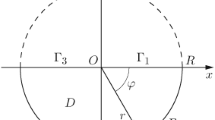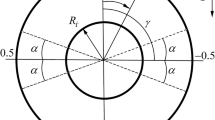Abstract
The investigation of thermal convection in a closed cavity is of considerable interest in connection with the problem of heat transfer. The problem may be solved comparatively simply in the case of small characteristic temperature difference with heating from the side, when equilibrium is not possible and when slow movement is initiated for an arbitrarily small horizontal temperature gradient. In this case the motion may be studied using the small parameter method, based on expanding the velocity, temperature, and pressure in series in powers of the Grashof number—the dimensionless parameter which characterizes the intensity of the convection [1–4]. In the problems considered it has been possible to find only two or three terms of these series. The solutions obtained in this approximation describe only weak nonlinear effects and the region of their applicability is limited, naturally, to small values of the Grashof number (no larger than 103).
With increase of the temperature difference the nature of the motion gradually changes—at the boundaries of the cavity a convective boundary layer is formed, in which the primary temperature and velocity gradients are concentrated; the remaining portion of the liquid forms the flow core. On the basis of an analysis of the equations of motion for the plane case, Batchelor [4] suggested that the core is isothermal and rotates with constant and uniform vorticity. The value of the vorticity in the core must be determined as the eigenvalue of the problem of a closed boundary layer. A closed convective boundary layer in a horizontal cylinder and in a plane vertical stratum was considered in [5, 6] using the Batchelor scheme. The boundary layer parameters and the vorticity in the core were determined with the aid of an integral method. An attempt to solve the boundary layer equations analytically for a horizontal cylinder using the Oseen linearization method was made in [7].
However, the results of experiments in which a study was made of the structure of the convective motion of various liquids and gases in closed cavities of different shapes [8–13] definitely contradict the Batchelor hypothesis. The measurements show that the core is not isothermal; on the contrary, there is a constant vertical temperature gradient directed upward in the core. Further, the core is practically motionless. In the core there are found retrograde motions with velocities much smaller than the velocities in the boundary layer.
The use of numerical methods may be of assistance in clarifying the laws governing the convective motion in a closed cavity with large temperature differences. In [14] the two-dimensional problem of steady air convection in a square cavity was solved by expansion in orthogonal polynomials. The author was able to progress in the calculation only to a value of the Grashof numberG=104. At these values of the Grashof numberG the formation of the boundary layer and the core has really only started, therefore the author's conclusion on the agreement of the numerical results with the Batchelor hypothesis is not justified. In addition, the bifurcation of the central isotherm (Fig. 3 of [14]), on the basis of which the conclusion was drawn concerning the formation of the isothermal core, is apparently the result of a misunderstanding, since an isotherm of this form obviously contradicts the symmetry of the solution.
In [5] the method of finite differences is used to obtain the solution of the problem of strong convection of a gas in a horizontal cylinder whose lateral sides have different temperatures. According to the results of the calculation and in accordance with the experimental data [9], in the cavity there is a practically stationary core. However, since the authors started from the convection equations in the boundary layer approximation they did not obtain any detailed information on the core structure, in particular on the distribution of the temperature in the core.
In the following we present the results of a finite difference solution of the complete nonlinear problem of plane convective motion in a square cavity. The vertical boundaries of the cavity are held at constant temperatures; the temperature varies linearly on the horizontal boundaries. The velocity and temperature distributions are obtained for values of the Grashof number in the range 0<G≤4·105 and for a value of the Prandtl number P=1. The results of the calculation permit following the formation of the closed boundary layer and the very slowly moving core with a constant vertical temperature gradient. The heat flux through the cavity is found as a function of the Grashof number.
Similar content being viewed by others
References
I. G. Shaposhnikov, “On the theory of weak convection”, ZhTF, vol. 22, no. 5, 1952.
E. M. Zhukovskii, “On free stationary convection in an infinite horizontal pipe”, ZhTF, vol. 22, no. 5, 1952.
E. Kh. Drakhlin, “On thermal convection in a spherical cavity”, ZhTF, vol. 22, no. 5, 1952.
G. K. Batchelor, “Heat transfer by free convection across a closed cavity between vertical boundaries at different temperatures”, Quart. Appl. Math., vol. 12, 3, 1954.
G. Z. Gershuni and E. M. Zhukhovitskii, “Closed convective boundary layer”, DAN SSSR, vol. 124, no. 2, 1959.
G. Z. Gershuni and E. M. Zhukhovitskii, “On heat transfer through a vertical slot of rectangular section with strong convection”, Inzh.-fiz. zh., vol. 3, no. 12, 1960.
S. Weinbaum, “Natural convection in a horizontal circular cylinder”, J. Fluid Mech., vol. 18, 409, 1964.
G. F. Shaidurov, “On convective heat transfer through a spherical cavity”, ZhTF, vol. 28, no. 4, 1958.
W. R. Martini and S. W. Churchill, “Natural convection inside a horizontal circular cylinder.” A. I. Ch. E. J., vol. 6, 251, 1960.
M. P. Sorokin, “Free convection of fluid in a cavity under boundary layer conditions”, Inzh.-fiz. zh., vol. 4, no. 8, 1961.
E. R. G. Eckert and W. O. Carlson, “Natural convection in an air layer enclosed between two vertical plates with different temperature”, Int. J. Heat and Mass Transfer, vol. 2, 1–2, 1961.
G. Mordhelles-Regnier, “Convection naturelle en espase confine”, Entropie, 1, 19, 1965.
J. W. Elder, “Laminar free convection in a vertical slot”, J. Fluid Mech., vol. 23, part 1, 77, 1965.
G. Poots, “Heat transfer by laminar free convection in enclosed plane gas layers”, Quart. J. Mech. Appl. Math., vol. 11, 257, 1958.
J. D. Hellums and S. W. Churchill, “Computation of natural convection by finite difference methods”, Int. Develop. Heat Transfer, part 5, 985, 1961.
A. Thom and C. Apelt, Field Computations in Engineering and Physics [Russian translation], Izd-vo Energia, 1964.
L. M. Simuni, “Numerical solutions of some problems of viscous fluid motion”, Inzh. zh., vol. 14, no. 3, 1964.
G. F. Shaidurov, “Stability of convective boundary layer in a fluid filling a horizontal cylinder”, Inzh.-fiz. zh., vol. 2, no. 12, 1964.
J. W. Elder, “Turbulent free convection in a vertical slot”, J. Fluid Mech., vol. 23, part 1, 99, 1965.
Author information
Authors and Affiliations
Rights and permissions
About this article
Cite this article
Gershuni, G.Z., Zhukhovitskii, E.M. & Tarunin, E.L. Numerical investigation of convective motion in a closed cavity. Fluid Dyn 1, 38–42 (1966). https://doi.org/10.1007/BF01022148
Issue Date:
DOI: https://doi.org/10.1007/BF01022148




